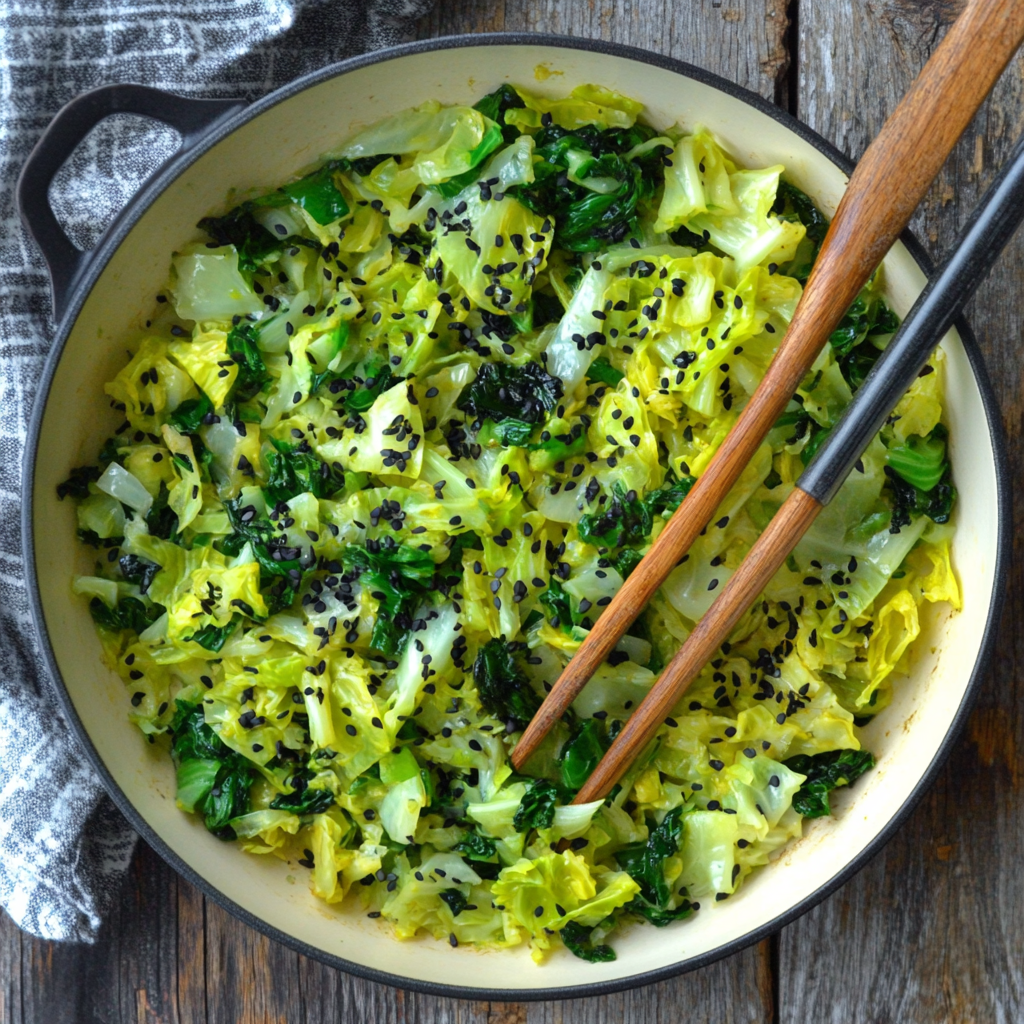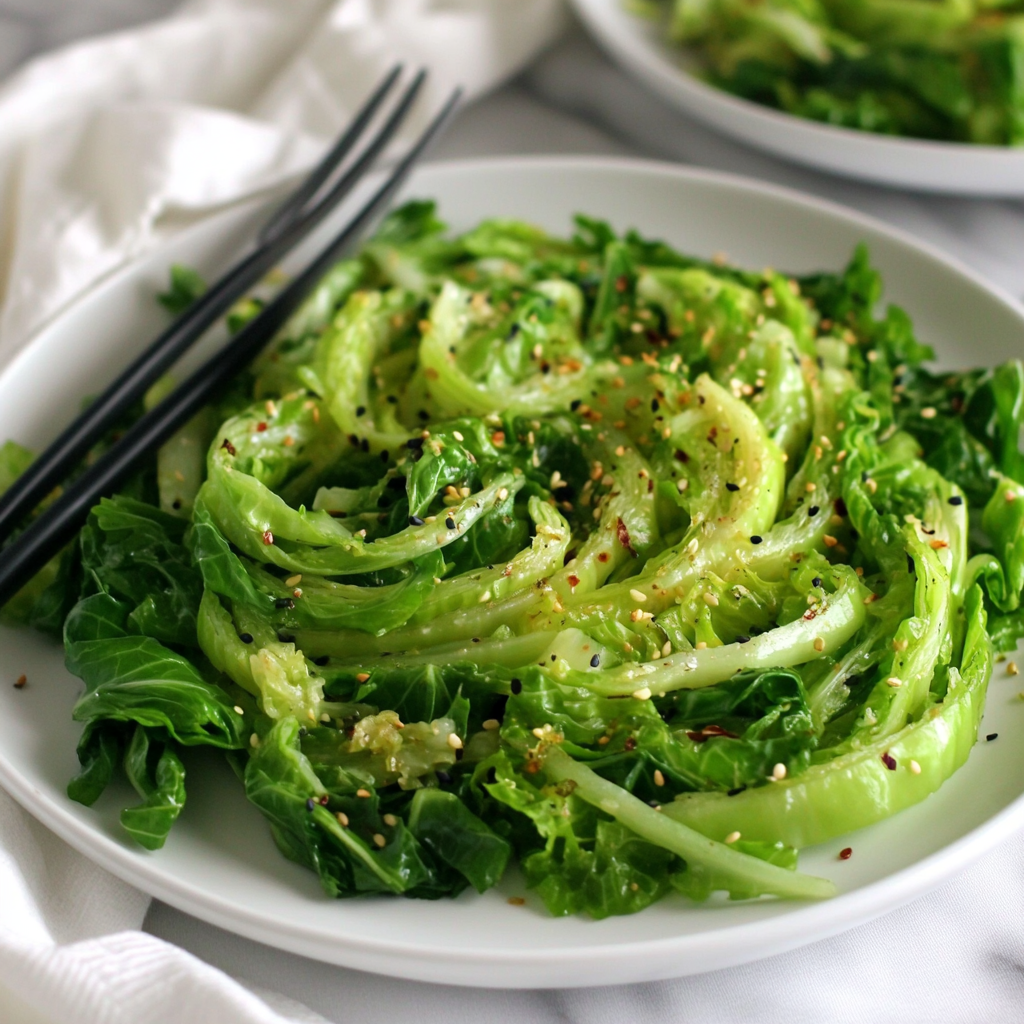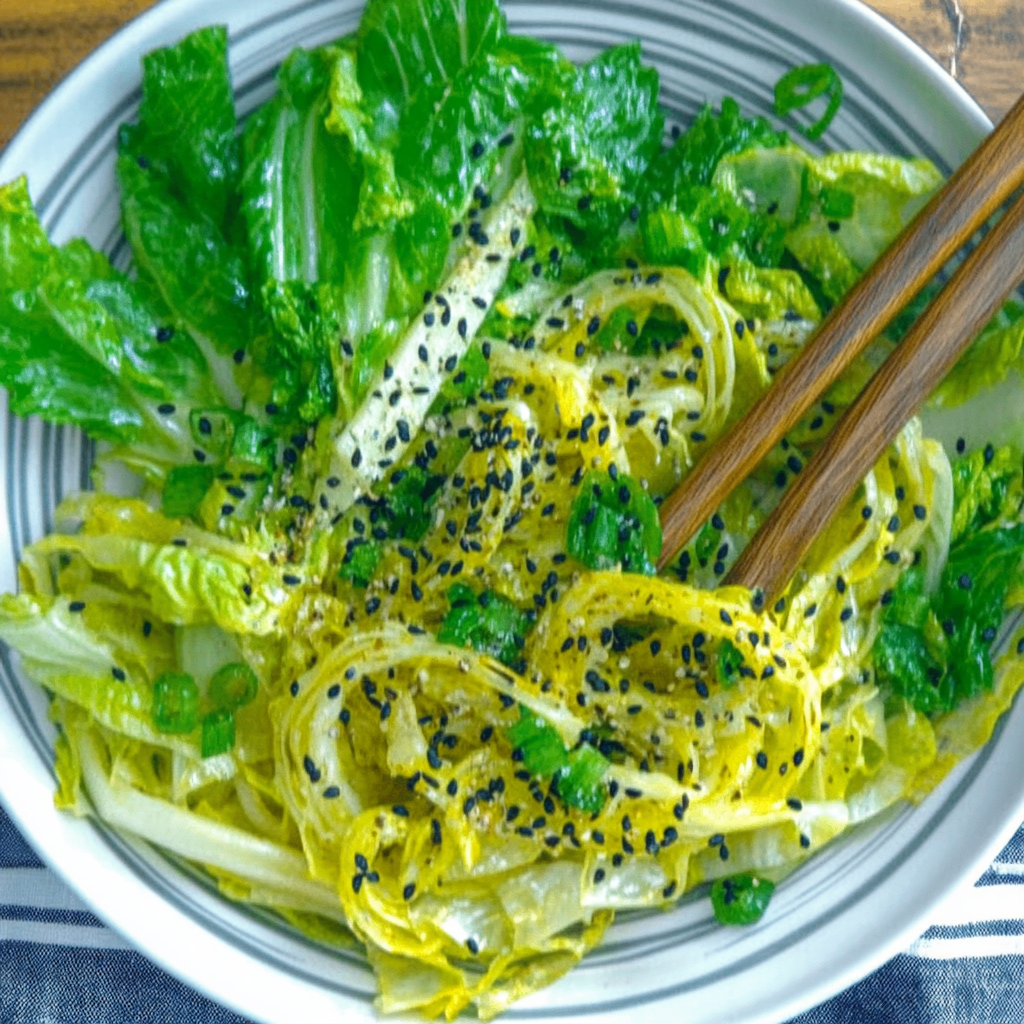*Napa cabbage, also known as Chinese cabbage, is a staple in Asian cuisine. Recognizable by its elongated shape and pale green, crinkled leaves, it offers a mild, slightly sweet flavor. This versatile vegetable is commonly used in dishes like kimchi, stir-fries, and soups. Its tender texture and subtle taste make it a favorite among chefs and home cooks alike.
Beyond its culinary appeal, napa cabbage boasts impressive health benefits. It’s rich in essential nutrients such as vitamins C and K, fiber, and antioxidants. These components support immune function, bone health, and digestion. Incorporating napa cabbage into your diet can contribute to overall well-being.
Selecting fresh napa cabbage is crucial for optimal flavor and nutrition. Look for heads that are firm, with crisp leaves free from blemishes. Proper storage extends its shelf life; keep it refrigerated and unwashed until ready to use. This ensures the cabbage retains its freshness and crunch.
Incorporating napa cabbage into your meals is simple. Its adaptability allows it to shine in various recipes, from traditional Asian dishes to modern fusion cuisine. Experimenting with napa cabbage can elevate your culinary creations and provide a nutritious boost to your diet.

Health Benefits of Napa Cabbage
Napa cabbage isn’t just delicious — it’s also packed with nutrients that promote optimal health. Its benefits go far beyond the plate.
Rich in vitamin C, it strengthens the immune system and helps fight off infections.
High in fiber, it improves digestion and supports gut health.
Contains vitamin K, which supports bone health and blood clotting.
In addition, napa cabbage is low in calories, making it ideal for weight management. For instance, its use in low-carb Asian meals adds both flavor and nutrition.
Even better, it’s full of antioxidants like beta-carotene and lutein. These may reduce inflammation and protect against chronic diseases. If you enjoy healthy bowls, try this nourishing Asian cabbage salad featuring fresh veggies and light dressing.
Adding napa cabbage to your diet is a smart, health-conscious choice that doesn’t sacrifice taste.
Selecting and Storing Napa Cabbage
Choosing the right napa cabbage is essential for flavor, freshness, and nutrition. Here’s how to pick the best one:
Look for firm, tightly packed heads with pale green leaves.
Avoid any with brown spots, wilting, or mushy areas.
Smaller heads are often sweeter and more tender.
Once selected, storing it correctly keeps it fresh longer. Wrap the cabbage in a paper towel and store it inside a perforated plastic bag. This helps prevent moisture buildup.
To extend its life, keep it unwashed in the crisper drawer. It stays fresh for up to two weeks when stored properly. If you’re preparing it for dishes like this chicken and cabbage stir-fry, prep just before cooking for best results.
Using fresh napa cabbage enhances taste and preserves its vitamin-rich profile, making your meals both vibrant and healthy.
Traditional Napa Cabbage Recipes
Kimchi : Traditional Korean fermented napa cabbage
Kimchi is a traditional Korean dish made by fermenting napa cabbage with various seasonings, resulting in a spicy, tangy flavor. This staple food is rich in probiotics, which support gut health.
Ingredients:
Napa cabbage
Korean radish
Scallions
Garlic
Ginger
Korean red pepper flakes (gochugaru)
Fish sauce or soy sauce
Salt
Preparation Steps:
Slice the napa cabbage lengthwise and salt it to draw out moisture.
Rinse the cabbage to remove excess salt.
Prepare a paste using garlic, ginger, gochugaru, and fish sauce.
Mix the cabbage with the paste, ensuring even coating.
Pack the mixture tightly into jars and ferment at room temperature for several days.
Incorporating kimchi into your diet offers numerous health benefits. It’s rich in vitamins A, B, and C, as well as minerals like iron and calcium. The fermentation process enhances its nutritional profile, introducing beneficial lactic acid bacteria that aid digestion.
Regular consumption of kimchi may support immune function, promote heart health, and assist in weight management. Its low-calorie content makes it a nutritious addition to various meals.
In summary, kimchi is a flavorful and health-promoting dish that showcases the versatility of napa cabbage. Whether enjoyed as a side or incorporated into recipes, it offers both taste and nutritional benefits.

Lion’s Head Meatballs with Napa Cabbage
Lion’s Head Meatballs is a classic Chinese dish featuring oversized, juicy pork meatballs simmered with napa cabbage. The name comes from the visual — the large meatballs resemble a lion’s head, while the cabbage mimics the mane.
Ingredients:
Ground pork
Napa cabbage, chopped
Water chestnuts (optional, for crunch)
Soy sauce and sesame oil
Scallions, garlic, and ginger
Chicken broth
Preparation Steps:
Mix ground pork with seasonings and form into large meatballs.
Brown meatballs lightly to seal in flavor.
Simmer in a broth with napa cabbage until fully cooked and tender.
This dish pairs perfectly with white rice or noodles. For a similar comforting Chinese-style recipe, check out this easy cabbage stir-fry that blends savory and fresh flavors beautifully.
Moreover, braising the meatballs allows them to soak up the umami-rich broth. The cabbage becomes soft and flavorful — similar to this braised cabbage and tofu recipe, which also highlights gentle cooking techniques.
Not only is this meal hearty, but it’s also a great way to enjoy protein and veggies together. Napa cabbage complements the richness of the pork, creating a balanced and satisfying dish perfect for any season.
Modern Interpretations and Fusion Recipes
Sautéed Napa Cabbage with Garlic and Soy Sauce
This quick sautéed napa cabbage recipe delivers bold flavor with just a few simple ingredients. It’s perfect for weeknight meals.
Ingredients:
1 head of napa cabbage, sliced
2 tablespoons soy sauce
2 cloves of garlic, minced
1 tablespoon oil (sesame or neutral)
Salt and pepper to taste
Preparation Steps:
Heat oil in a large pan and sauté garlic until fragrant.
Add sliced napa cabbage and cook for 2–3 minutes.
Stir in soy sauce and cook until tender but crisp.
Season lightly and serve warm.
This dish is incredibly versatile and pairs well with rice, noodles, or proteins. For a great pairing, try it with this flavorful Asian chicken stir-fry, which also balances savory and crisp textures.
Even better, this sautéed cabbage works as a light side for heavier meals. If you’re into low-effort but tasty veggie sides, check out this cabbage and carrot sauté.
Garlic and soy sauce enhance the natural sweetness of napa cabbage, turning a humble vegetable into a crave-worthy dish in minutes.

Napa Cabbage Salad with Sesame Dressing
This crisp napa cabbage salad is refreshing, light, and tossed in a creamy sesame dressing that adds rich umami depth.
Ingredients:
1/2 head of napa cabbage, thinly sliced
1 shredded carrot
2 tablespoons toasted sesame seeds
2 tablespoons rice vinegar
1 tablespoon sesame oil
1 tablespoon soy sauce
1 teaspoon honey or maple syrup
Preparation Steps:
Combine dressing ingredients in a small bowl and whisk until smooth.
Toss cabbage, carrot, and sesame seeds in a large bowl.
Pour dressing over the salad and mix well. Serve immediately.
This salad offers crunch and balance — perfect with grilled meats or tofu. For more cabbage-based fresh meals, explore this tasty Asian cabbage chicken salad recipe that’s packed with flavor.
Also, if you’re craving healthy lunch ideas, check out this low-carb chicken cabbage bowl that pairs great with this sesame dressing.
The nutty, tangy flavor from the dressing makes this salad a standout. Plus, it’s fast, easy, and full of fiber and vitamins.
Napa Cabbage Stir-Fry with Tofu
This napa cabbage stir-fry with tofu is a satisfying, protein-packed dish that’s perfect for meatless meals.
Ingredients:
1 block firm tofu, cubed
1/2 head napa cabbage, chopped
2 tablespoons soy sauce
1 tablespoon sesame oil
Garlic and ginger, minced
Preparation Steps:
Sauté tofu until golden. Remove and set aside.
Stir-fry garlic, ginger, and napa cabbage until wilted.
Return tofu, add soy sauce, and stir to combine.
This dish is light yet filling. For more meatless meals, try this tofu cabbage stir-fry that offers similar flavor and ease.
Or for a spicy twist, pair it with this bold spicy cabbage noodles recipe. Both bring out the best in tofu and cabbage.
International Dishes Featuring Napa Cabbage
Cap Cai – Indonesian-Chinese Mixed Vegetable Stir-Fry
Cap Cai is a vibrant stir-fry dish originating from Chinese-Indonesian cuisine. It’s loaded with colorful vegetables, often including napa cabbage.
Common Ingredients:
Napa cabbage, chopped
Carrots, broccoli, and baby corn
Garlic and onions
Chicken or shrimp (optional)
Soy sauce and oyster sauce
A dash of sesame oil
Preparation Steps:
Stir-fry garlic and onions until fragrant.
Add vegetables and protein of choice.
Pour in sauces and stir until vegetables are just tender.
This dish is both flexible and flavorful. You can keep it vegetarian or include meat. For another veggie-packed stir-fry, try this easy chicken cabbage stir-fry that’s ideal for weeknights.
Want a dish with similar bold flavors and texture? Explore the Asian veggie bowl for another balanced and colorful option.
Cap Cai brings together texture, nutrition, and a burst of umami — all in under 20 minutes.

Dongchimi – Mild Korean Water Kimchi
Dongchimi is a type of water kimchi made with radish and napa cabbage. It’s crisp, tangy, and lightly fermented.
Common Ingredients:
Korean radish, peeled and cut
Napa cabbage, chopped
Garlic, ginger, and green onions
Salt and sugar
Cold water
Preparation Steps:
Salt the radish and cabbage, then let them sit for several hours.
Rinse, combine with aromatics, and submerge in cool water.
Store in a sealed jar and ferment in the fridge for 2–4 days.
The result is a refreshing, lightly sour broth that’s often served with rice or noodles. For a deeper kimchi flavor, you may enjoy this classic kimchi recipe featuring spicier fermentation.
Alternatively, explore this low-spice cabbage side if you’re looking for gentle flavors with lots of crunch.
Low in calories and rich in probiotics, dongchimi supports gut health while adding brightness to Korean meals.
Nabak-kimchi – Light Water Kimchi with Napa Cabbage
Nabak-kimchi is a refreshing Korean water kimchi made with napa cabbage and radish, known for its subtle, mild taste.
Key Ingredients:
Thinly sliced napa cabbage
Korean radish, julienned
Carrot, red pepper, green onion
Garlic, ginger, and salted water
Preparation Steps:
Soak vegetables briefly in salted water.
Add aromatics and let ferment in the refrigerator.
This kimchi is perfect for warmer weather. If you prefer something spicier, try this bold homemade kimchi recipe loaded with heat and flavor.
For a softer veggie option, this tofu cabbage stir-fry offers a savory, warming contrast.
Nabak-kimchi delivers crisp texture, clean flavors, and healthy probiotics, all in a simple, hydrating side dish.
Cooking Techniques for Napa Cabbage
Napa cabbage is incredibly versatile and adapts to a variety of cooking techniques. Each method brings out unique textures and flavors.
1. Sautéing:
Quick and simple.
Use garlic, soy sauce, or sesame oil for flavor.
Ideal for stir-fries and side dishes.
For example, this garlic soy sautéed cabbage makes a great base or pairing for proteins.
2. Stir-Frying:
High heat locks in nutrients.
Combine with tofu, chicken, or veggies.
Add sauces toward the end to prevent burning.
If you’re looking for a fast, full meal, try this popular chicken cabbage stir-fry for balanced texture and flavor.
3. Fermenting:
Common in Korean cuisine (kimchi, dongchimi).
Preserves the cabbage while boosting probiotic content.
Use airtight jars and store in cool spaces.
Fermenting enhances not just flavor, but gut health too. For a deeper dive, check this homemade kimchi guide.
Whether you’re stir-frying, sautéing, or fermenting, napa cabbage adapts beautifully — offering both nutrition and flavor in every bite.
Frequently Asked Questions (FAQs)
1. What’s the difference between napa cabbage and regular green cabbage?
Napa cabbage has a more tender texture and milder flavor. It’s oblong with crinkled leaves, unlike round, firm green cabbage.
2. Can you eat napa cabbage raw?
Absolutely! It’s delicious in salads like this crunchy Asian cabbage salad with chicken, offering a naturally sweet and crisp bite.
3. How do you store napa cabbage properly?
Wrap it in a paper towel and place it inside a perforated plastic bag. Refrigerate unwashed for up to two weeks.
4. Is napa cabbage good for fermentation?
Yes, it’s the key ingredient in many fermented dishes, including homemade kimchi and mild water kimchis like dongchimi.
5. What can I substitute for napa cabbage in recipes?
Try savoy cabbage or bok choy. Both offer similar texture and work well in stir-fries or soups.
6. Does cooking reduce the nutritional value of napa cabbage?
Some vitamins may reduce with heat, but it still retains fiber and minerals, especially when stir-fried or sautéed lightly.

